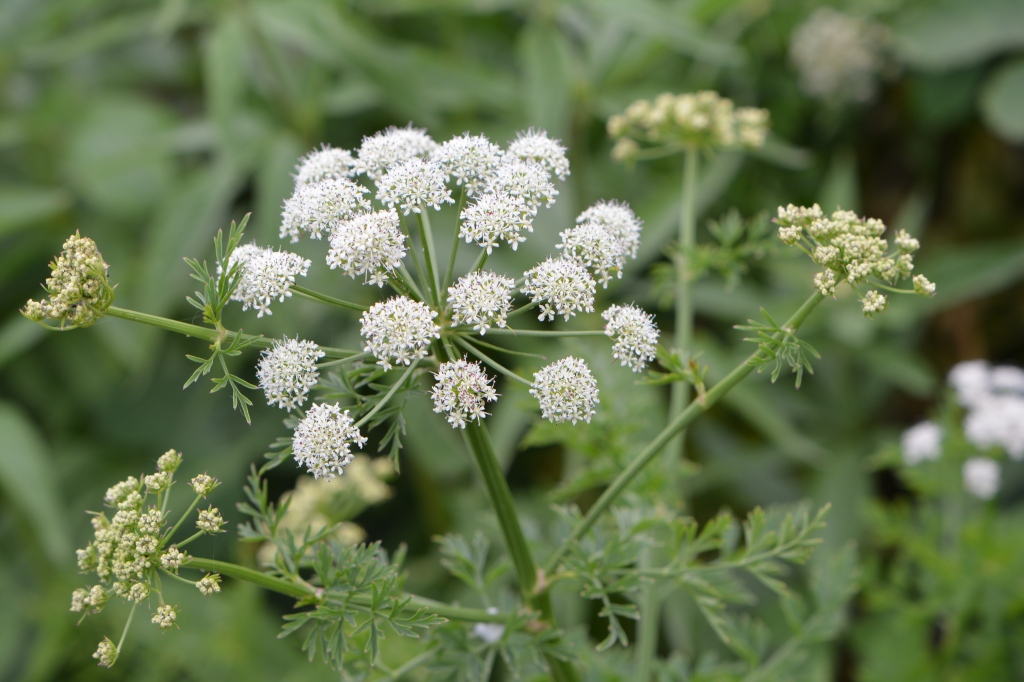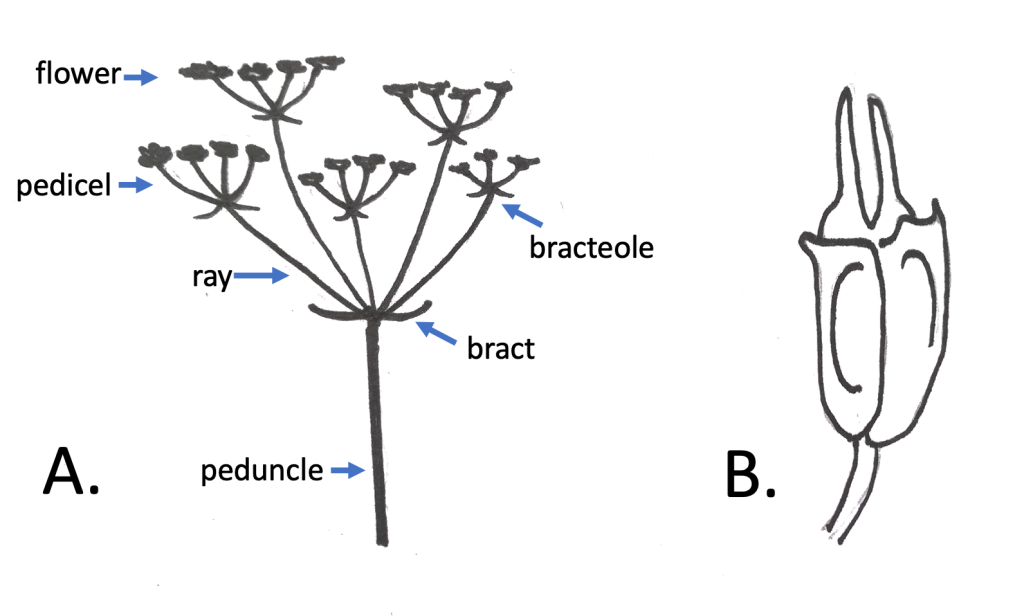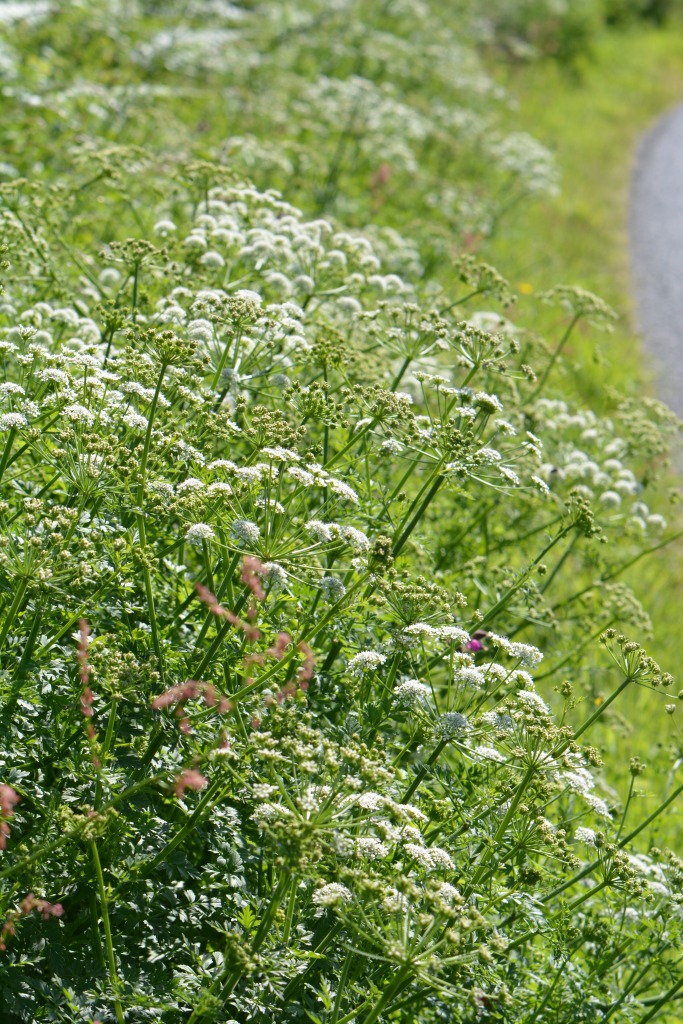The West coast of Scotland is quite different from the East. It is wilder, lashed by an ocean, and relatively untamed. Its plant life is different too. Oenanthe crocata, Hemlock Water Dropwort, is one of several species that grows freely on the west coast but it’s quite hard to find on the East. Its decorative white umbels by the roadside in the wetter parts of Scotland can sometimes rival the frothy display of the familiar cow parsley.

Oenanthe crocata is a native perennial in the carrot family, the Apiaceae (formerly called the Umbelliferae). It grows to about 1.5 metres, and is often found in clumps several metres across. Most members of this family are packed with defensive chemicals – some give us much-loved culinary flavours (parsnip, celery, coriander, cumin, parsley) but others can poison us. The three deadliest members of the family are: Hemlock Water-dropwort (Oenanthe crocata), Hemlock (Conium maculatum), and Cow-bane (Cicuta virosa). Local councils seem blissfully unaware of the hazard posed by these species and allow them to flower and seed profusely (sometimes in the most public of places) whilst concentrating their own chemical fire-power on the harmless urban flora which they call ‘weeds’.
That was a little rant. Moving on: in this blog we concentrate on Hemlock Water-dropwort, but I’d like to return to Hemlock and Cow-bane later in the year. It’s a plant that likes damp places: river-sides and ditches suit it well. It tolerates sea-spray and stands up to gale-force winds. The high rainfall and consequent wetness of the soil may account for its more widespread distribution in the west of Scotland.

What are its key features, and can it be confused with related species? It has the characteristic umbels that nearly all the family members have. In case you are unsure of what we mean by an umbel, and being mindful that “a picture is worth a thousand words” see my drawing of a schematic umbel. Members of the Apiaceae differ in such things as the number of rays and the development of bracts and bracteoles. Hemlock Water-dropwort has 20-50 rays, 3-6 inconspicuous bracts, 3-8 small bracteoles and a deeply grooved and hairless green stem that’s hollow. The entire umbel is shaped like a dome and the arrangement of the rays is highly regular to make a rather architectural substructure on which the flowers are mounted. The hundreds of tiny flowers look like one single flower from afar and the appearance and smell attracts all kinds of insect life. Pollination in most of this family is described as ‘promiscuous’, meaning that the flower is open to all-comers. Leaves are also useful distinguishing features. The leaves of Oenothera crocata are hairless, they look a lot like the flat-leaved parsley you’ll find in any herb garden, but they are stiffer and slightly bluish. These few characters are nearly enough to identify it, but for a certain identification of members of the Apiaceae you must wait for the flower to develop into a fruit. The shape of the fruit is diagnostic.

Its ecology is not well known. I searched the Web of Science but found only 30 publications. Almost all of them were related to poisoning of humans or horses, or the chemistry of the toxic compound. Nor could I find any PhD dissertation about it.

Its geographical distribution is remarkable. Its European distribution shows a concentration in the West of Britain and Ireland, France and Spain, but it does extend deep into the Mediterranean (Sardinia in particular). In those otherwise dryer climes, I suspect it is restricted to marshland but this is something to investigate further. In the British Isles it has increased hugely in Ireland and some parts of central England.

Recently it has appeared as an unwanted alien in Argentina (Martinez et al 2012), where it is called nabo del diablo, which translates as Devil’s Turnip. But it does not resemble turnip. The large below-ground structures are tubers – not the same as the tap roots that are common elsewhere in the Apiaceae (as in carrot and parsnip). Are these for dispersal or merely for storage of carbohydrates? How does it spread? I have been unable to find seedlings, but I shall continue to search. Possibly it spreads locally via the tubers being washed away when the land is flooded, to form the characteristic clumps in ditches. Do the seeds float? This seems quite likely but needs investigation.
The toxic compound is oenanthotoxin, which poisons the central nervous system of mammals. It is a strange molecule, not a ring structure but a long thin arrangement of 17 carbon atoms. Its short chemical name is polyacetylene, and it is like the cicutoxin found in Cow-bane but quite unlike the alkaloid compound called coniine, the poison of Hemlock. The symptoms of poisoning include convulsions, seizures, nausea, diarrhoea and tachycardia. Quite small amounts can be lethal (lethal dose for mice is only 0.58 mg per kg). I’ve read that it tastes sweetish, not bitter like many poisonous plants. In evolutionary terms, it is hard to make sense of that. The whole point of any chemical defence is to ward off herbivores and that is usually achieved by having a bad taste rather than killing the herbivore later on. I am loath to taste it for obvious reasons. Dear reader, please don’t try.
In Pre-Roman Sardinia Oenanthe was used as a humane agent of euthanasia. Old folk, unable to fend for themselves, were given an extract of the plant and when their faces became contorted into what appeared to be a smile, they were dropped from a high rock to make sure they were dead. This smile is called risus sardonicus by physicians, and hence the use of the term sardonic smile.
Socrates died of Hemlock poisoning. However, historians cannot be sure which plant was responsible for the death of Socrates. Sullivan (2001) and others think that the symptoms could not have been caused by Conium, and that the poison is more likely to have been from Oenanthe. Moreover, there are many species of both Oenanthe and Conium. The story as told by Plato is that Socrates was accused of corrupting the minds of the young people of Athens and he was sentenced to death by drinking a Hemlock concoction. He died, of course. But he took the chalice and drank the juice with no apparent fear, as a lesson to his followers, and so the death is usually called a suicide.
There are plenty of cases of poisoning in the medical journals. Downs et al (2002) describe how young adults on holiday in Argyll mistook the plant for wild parsnip and incorporated the tubers into a curry. They were very ill, with grand mal seizures. Those not in hospital failed to make a connection between the illness and their wild parsnip dinner. They ate the left-overs the next day and fell ill. With hospital treatment all victims survived, perhaps because the act of boiling destroys some of the poison, but it was a close call.
In highly diluted form the toxin is a muscle relaxant and so the species may have value in medicine. Several members of the genus Oenanthe are on sale for people with ponds, but O. crocata isn’t available to grow in your garden. However, extracts of it are on sale – for homeopathy.
John Grace
References
Downs C et al (2002) A hemlock water dropwort curry: a case of multiple poisoning. Emergency Medicine Journal 19, 472-473.
Martinez S et al. (2012) Oenanthe crocata (Apiaceae, Apioideae) Planta toxica nueva para la flora adventicia de Argentina y America. Darwiniana 50, 97-106.
Sullivan J (2001) A note on the death of Socrates. The Classical Quarterly 51, 608-610.


One thought on “Plant of the Week – June 21st 2021- Hemlock Water-dropwort, Oenanthe crocata”